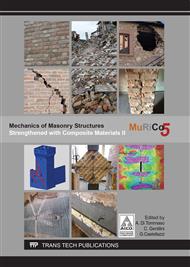[1]
A. Acciai, A. D'Ambrisi, M. De Stefano, R. Nudo, L. Feo, F. Focacci, Experimental response of FRP reinforced members without transverse reinforcement: Failure modes and design issues, Compos Part B 89 (2016) 397-407.
DOI: 10.1016/j.compositesb.2016.01.002
Google Scholar
[2]
A. D'Ambrisi, F. Focacci, R. Luciano, Experimental investigation on flexural behavior of timber beams repaired with CFRP plates, Composite Structures 108(1) (2014) 720-728.
DOI: 10.1016/j.compstruct.2013.10.005
Google Scholar
[3]
F. Capani, A. D'Ambrisi, M. De Stefano, R. Nudo, F. Focacci, R. Luciano, R. Penna, Experimental investigation on cyclic response of RC elements repaired by CFRP external reinforcing systems, Compos Part B 112 (2017) 290-299.
DOI: 10.1016/j.compositesb.2016.12.053
Google Scholar
[4]
American Concrete Institute, ACI 440. 2R-08 Guide for the Design and Construction of Externally Bonded FRP Systems for Strengthening Concrete Structures, 2008, Farmington Hills, MI, 77 pp.
DOI: 10.14359/51700867
Google Scholar
[5]
CNR-DT 200 R1/2013, Guide for the Design and Construction of Externally Bonded FRP Systems for Strengthening Existing Structures, Italian National Research Council (CNR), Rome 2013, 144 pp.
Google Scholar
[6]
A. Di Tommaso, F. Focacci, Strengthening Historical Monuments with FRP: a Design Criteria Review, Composites in Construction: a Reality, ASCE (2001), ISBN 0-7844-0596-4.
DOI: 10.1061/40596(264)24
Google Scholar
[7]
American Concrete Institute (ACI) 549. 4R-13, Guide to Design and Construction of Externally Bonded Fabric-Reinforced Cementitious Matrix (FRCM) Systems for Repair and Strengthening Concrete and Masonry Structures; ACI: Farmington Hills, MI, USA, (2013).
DOI: 10.1016/j.prostr.2018.11.027
Google Scholar
[8]
A. D'Ambrisi, F. Focacci, Flexural strengthening of RC beams with cement based composites. J Compos Constr 15(2) (2011) 707-720.
DOI: 10.1061/(asce)cc.1943-5614.0000218
Google Scholar
[9]
A. D'Ambrisi, L. Feo, F. Focacci, Experimental analysis on bond between PBO-FRCM strengthening materials and concrete, Compos Part B 44(1) (2013) 524–532.
DOI: 10.1016/j.compositesb.2012.03.011
Google Scholar
[10]
A. D'Ambrisi, L. Feo, F. Focacci, Experimental and analytical investigation on bond between Carbon-FRCM materials and masonry, Compos Part B 46 (2013) 15-20.
DOI: 10.1016/j.compositesb.2012.10.018
Google Scholar
[11]
G. De Felice, S. De Santis, L. Garmendia, B. Ghiassi, P. Larrinaga, P.B. Lourenco, D.V. Oliveira, F. Paolacci, G.C. Papanicolaou, Mortar-based systems for externally bonded strengthening of masonry, Mater and Struct 47 (2014) 2021-(2037).
DOI: 10.1617/s11527-014-0360-1
Google Scholar
[12]
F.G. Carozzi, C. Poggi. Mechanical properties and debonding strength of Fabric Reinforced Cementitious Matrix (FRCM) systems for masonry strengthening, Compos Part B 70 (2015) 215-230.
DOI: 10.1016/j.compositesb.2014.10.056
Google Scholar
[13]
T. D'Antino, C. Carloni, L.H. Sneed, C. Pellegrino, Matrix-fiber bond behavior in PBO FRCM composites: A fracture mechanics approach, Eng Fract Mech 117(2) (2014) 94–111.
DOI: 10.1016/j.engfracmech.2014.01.011
Google Scholar
[14]
C. Carloni, T. D'Antino, L.H. Sneed, C. Pellegrino, Role of the Matrix Layers in the Stress Transfer Mechanism of FRCM Composites Bonded to a Concrete Substrate. J Eng Mech 141(6) (2014).
DOI: 10.1061/(asce)em.1943-7889.0000883
Google Scholar
[15]
C. Carloni, D. Bournas, F. Carozzi, T. D'Antino, G. Fava, F. Focacci, G. Giacomin, G. Mantegazza, C. Pellegrino, C. Perinelli C. Poggi, Fiber reinforced composites with cementitious (Inorganic) matrix, RILEM State-of-the-Art Reports 19 (2016).
DOI: 10.1007/978-94-017-7336-2_9
Google Scholar
[16]
M. Malena, G de Felice, F. Focacci, C. Carloni C, The effect of the shape of the cohesive material law on the stress transfer at the FRP-masonry interface, Compos Part B 110 (2017) 368-380.
DOI: 10.1016/j.compositesb.2016.11.012
Google Scholar
[17]
C. Carloni, K.V. Subramaniam, Application of fracture mechanics to debonding of FRP from RC members, ACI SP 286-10, (2012).
DOI: 10.14359/51683910
Google Scholar
[18]
F. Focacci, C. Carloni, Periodic variation of the transferable load at the FRP-masonry interface. Composite Structures 129 (2015) 90-100.
DOI: 10.1016/j.compstruct.2015.03.008
Google Scholar
[19]
C. Carloni, F. Focacci. FRP-masonry interfacial debonding: An energy balance approach to determine the influence of the mortar joints. European Journal of Mechanics A/Solids 55 (2016) 122-133.
DOI: 10.1016/j.euromechsol.2015.08.003
Google Scholar
[20]
A. D'Ambrisi, F. Focacci, A. Caporale, Strengthening of masonry unreinforced concrete railway bridges with PBO-FRCM materials, Compos Struct102 (2013) 193-204.
DOI: 10.1016/j.compstruct.2013.03.002
Google Scholar
[21]
A. D'Ambrisi, F. Focacci, R. Luciano, V. Alecci, M. De Stefano, Carbon-FRCM materials for structural upgrade of masonry arch road bridges, Compos Part B 75 (2015) 355-366.
DOI: 10.1016/j.compositesb.2015.01.024
Google Scholar
[22]
V. Alecci, F. Focacci, L. Rovero, G. Stipo, M. De Stefano, Extrados strengthening of brick masonry arches with PBO-FRCM composites: experimental and analytical investigations, Compos Struct 149(1) (2016) 184-196.
DOI: 10.1016/j.compstruct.2016.04.030
Google Scholar
[23]
L. Rovero, F. Focacci, G. Stipo, Structural behavior of arch models strengthened using FRP strips of different lengths, J. Compos. Constr. 17(2) (2013) 249-258.
DOI: 10.1061/(asce)cc.1943-5614.0000325
Google Scholar
[24]
P. Foraboschi, Strengthening of masonry arches with fiber-reinforced polymer strips. J. Compos. Constr. 8(3) (2004) 191-202.
DOI: 10.1061/(asce)1090-0268(2004)8:3(191)
Google Scholar
[25]
P. Foraboschi, Church of San Giuliano di Puglia: Seismic repair and upgrading. Eng. Fail. Anal. 33 (2013) 281-314.
DOI: 10.1016/j.engfailanal.2013.05.023
Google Scholar
[26]
A. D'Ambrisi, L. Feo, F. Focacci, Masonry arches strengthened with composite unbonded tendons. Comp. Struct. 98 (2013) 323-329.
DOI: 10.1016/j.compstruct.2012.10.040
Google Scholar


